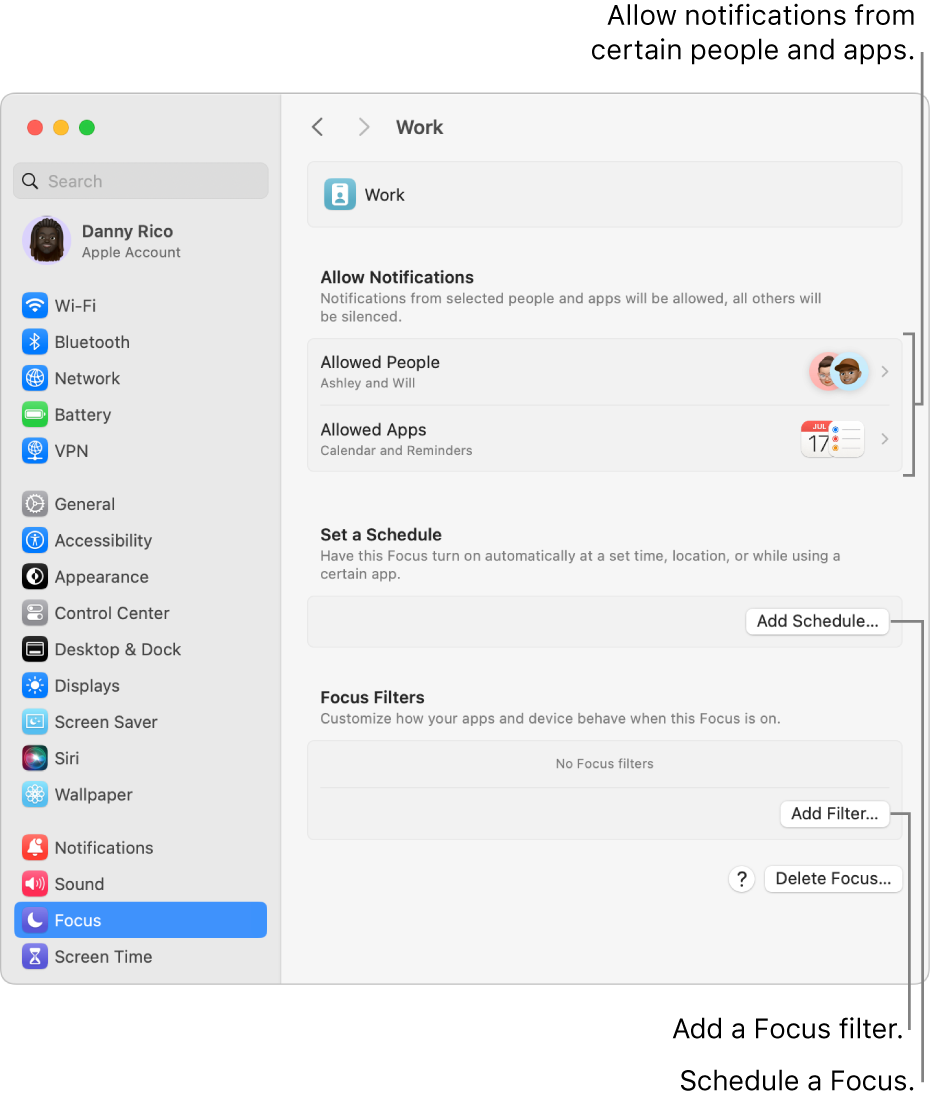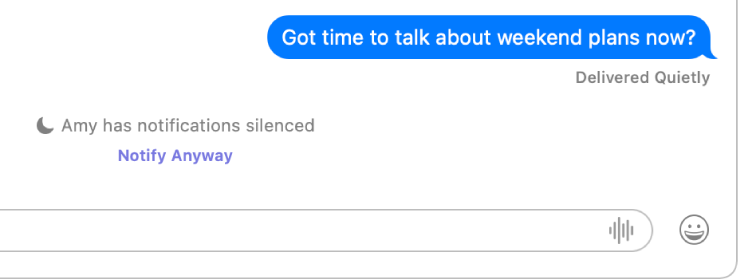
Set up a Focus on Mac
When you need to stay on task and minimise distractions, use Focus. You can use a Focus to pause and silence all notifications or allow only certain notifications — for example, ones from colleagues on an urgent project. You can also share that you’ve silenced notifications so contacts know you’re busy.

Tip: Need to quickly silence all notifications? Turn on the Do Not Disturb Focus in Control Centre.
Add or remove a Focus
On your Mac, choose Apple menu

 in the sidebar. (You may need to scroll down.)
in the sidebar. (You may need to scroll down.)Do any of the following:
Add a provided Focus: Click Add Focus, then click a Focus, such as Gaming or Work.
Create a custom Focus: Click Add Focus, then click Custom. Enter a name, select a colour and icon, then click OK. For example, you might create a Study Focus. You can create up to ten.
Change a custom Focus: Click a custom Focus in the list. Click the icon to change the name, colour or icon of the Focus.
Remove a Focus: Click a Focus in the list, then click Delete Focus at the bottom of the window.
A custom Focus is deleted. A provided Focus, such as Reading or Mindfulness, is removed from the list but is still available to add again later.
If you keep Focus up to date across your Apple devices, the changes you make on your Mac are reflected on your other devices.
Choose which notifications to allow
You can specify which notifications are shown when a Focus is active — for example, notifications from certain people and apps, time-sensitive notifications or notifications for phone calls received on your Mac.
Note: Some apps, such as Calendar, have time-sensitive notifications. To ensure you receive these notifications, select the option to allow them.
On your Mac, choose Apple menu

 in the sidebar. (You may need to scroll down.)
in the sidebar. (You may need to scroll down.)Click a Focus.
Go to Allow Notifications, click Allowed People, then do any of the following (click Done when you’re finished):
Allow notifications from certain people: Click the pop-up menu next to Notifications, then choose Allow Some People. Click
 , then select one or more contacts. For example, for the Gaming Focus, you might select the friends you usually play with in multiplayer games.
, then select one or more contacts. For example, for the Gaming Focus, you might select the friends you usually play with in multiplayer games.To remove a person from the list, hold the pointer over the person’s name, then click
 .
.Silence notifications from certain people: Click the pop-up menu next to Notifications, then choose Silence Some People. Click
 , then select one or more contacts.
, then select one or more contacts.To remove a person from the list, hold the pointer over the person’s name, then click
 .
.Allow notifications for phone calls: Click the pop-up menu next to “Allow calls from”, then choose an option. You can receive notifications for calls from everybody, allowed people only, only people in your contacts list in Contacts, or only people in your Favourites on iPhone.
Allow notifications for repeated phone calls: Turn on “Allow repeated calls” to receive notifications from anyone who calls two or more times within three minutes.
Go to Allow Notifications, click Allowed Apps, then do any of the following (click Done when you’ve finished):
Allow notifications from certain apps: Click the Notifications pop-up menu, then choose Allow Some Apps. Click the Add button, select one or more apps, then click Add. For example, for the Work Focus, you might allow notifications only from the apps you need to do your work.
To remove an app from the list, hold the pointer over the app, then click
 .
.Silence notifications from certain apps: Click the Notifications pop-up menu, then choose Silence Some Apps. Click the Add button, select one or more apps, then click Add.
To remove an app from the list, hold the pointer over the app, then click
 .
.Allow notifications for events or tasks that require your immediate attention: Turn on Time Sensitive Notifications. (Make sure you also select the option that allows apps to send these notifications in Notifications settings.)
The Gaming Focus is set by default to turn on whenever a gaming controller is connected with your Mac. To receive notifications when the Gaming Focus is on, make sure you specify people or apps.
Schedule a Focus to turn on or off automatically
You can schedule a Focus to automatically turn on or off at certain times, when you arrive at or leave certain locations, or when you open or close certain apps.
On your Mac, choose Apple menu

 in the sidebar. (You may need to scroll down.)
in the sidebar. (You may need to scroll down.)Click a Focus.
Go to Set a Schedule, click Add Schedule, then do any of the following:
Set up a time-based schedule: Click Time, enter a start and end time, select the days of the week you want the schedule to operate, then click Done.
If you want to change a time-based schedule, click it, change the settings, then click Done.
To temporarily stop using a time-based schedule, click it, turn off Schedule at the top of the window, then click Done.
Set up a location-based schedule: Click Location, enter a place name in the Search field, select a location, then click Done.
When you schedule a Focus based on your location, the Focus turns on when you arrive at the location and turns off when you leave.
To temporarily stop using a location-based schedule, click it, turn off Automation at the top of the window, then click Done.
You must have Location Services enabled in Privacy settings to use a location.
Set up an app-based schedule: Click App, enter an app name in the Search field, select an app, then click Done.
When you schedule a Focus based on an app, the Focus turns on when you open the app, and turns off when you close it or switch to another app.
To temporarily stop using an app-based schedule, click it, turn off Automation at the top of the window, then click Done.
Customise app behaviour
Add a Focus filter to customise how Calendar, Mail, Messages or Safari behave when a Focus is turned on. For example, choose a set of Tab Groups to appear in Safari while in the Work Focus, or hide your work calendar when you’re using the Personal Focus.
On your Mac, choose Apple menu

 in the sidebar. (You may need to scroll down.)
in the sidebar. (You may need to scroll down.)Click a Focus.
Go to Focus Filters, click Add Filter, then do any of the following:
Set up a Focus filter for Calendar: Click Calendar, select the calendars you want to see when this Focus is on, then click Add.
Set up a Focus filter for Mail: Click Mail, select the email accounts you want to see when this Focus is on, then click Add.
Set up a Focus filter for Messages: Click Messages, turn on Filter by People List, then click Add.
Set up a Focus filter for Safari: Click Safari, click Choose next to Tab Group, select the Tab Group you want to see when this Focus is on, turn “Open external links in your Focus Tab Group” on or off, then click Add.
After you set up a Focus Filter, you can change it or temporarily stop using it. Choose Apple menu 
![]() in the sidebar, click a Focus, then click the Focus Filter you want to change. Use the button at the top of the window to turn the Focus Filter on or off, or make changes to the settings. Click Done when you’re finished.
in the sidebar, click a Focus, then click the Focus Filter you want to change. Use the button at the top of the window to turn the Focus Filter on or off, or make changes to the settings. Click Done when you’re finished.
To remove a Focus Filter, choose Apple menu 
![]() in the sidebar, click a Focus, click the Focus Filter you want to remove, then click Delete App Filter at the bottom of the window.
in the sidebar, click a Focus, click the Focus Filter you want to remove, then click Delete App Filter at the bottom of the window.
Keep Focus settings up to date across your Apple devices
When you’re signed in to the same Apple Account on all your Apple devices, any changes you make to Focus are reflected on your other devices, and turning a Focus on or off on one device turns it on or off on your other devices.
On your Mac, choose Apple menu

 in the sidebar. (You may need to scroll down.)
in the sidebar. (You may need to scroll down.)Turn “Share across devices” on or off. (The option is on by default.)
Share your Focus status
You can set an option that lets apps indicate to contacts who send you a message that you’ve silenced notifications (they don’t see which Focus you’re using). If something’s important, they can choose to notify you anyway.

On your Mac, choose Apple menu

 in the sidebar. (You may need to scroll down.)
in the sidebar. (You may need to scroll down.)Click “Focus status”.
Turn on “Share Focus status”.
Click “Focus status”.
